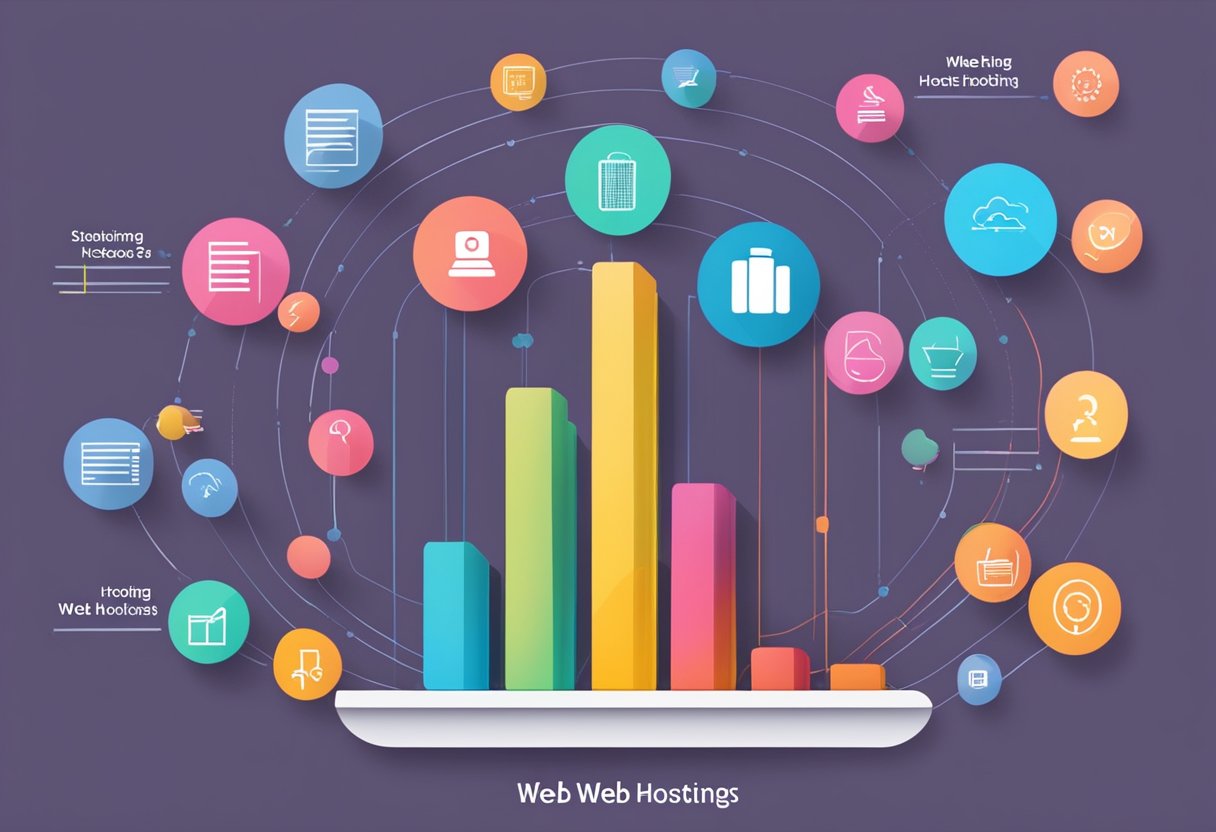Choosing the best web hosting service is crucial for anyone starting their journey online. For beginners, Hostinger stands out as an excellent choice due to its user-friendly interface and supportive features that make website creation straightforward. With various options available, understanding what to look for in a web host can significantly impact the success of a new website.
Many hosting providers cater to beginner needs, offering essential tools for site management and development. Factors such as cost, reliability, and customer support play a vital role in selecting the right host. Learning about these criteria can empower new users to make informed decisions as they set up their first online presence.
Key Takeaways
- Hostinger is an ideal choice for beginners due to its ease of use.
- Understanding the important features helps in selecting a suitable web host.
- Reliable customer support is essential for maintaining a successful website.
Understanding Web Hosting

Web hosting is essential for individuals and businesses aiming to establish an online presence. Understanding its components can help users make informed choices and select the right hosting solution.
What Is Web Hosting?
Web hosting is a service that enables individuals and organizations to make their websites accessible on the internet. It provides the infrastructure and technologies required to store website files, such as HTML, CSS, images, and scripts.
When a user types a website address into a browser, it sends a request to the hosting server. The server processes this request and delivers the requested web pages to the user’s browser.
There are various types of web hosting environments, each suited for different needs. Hosting can range from shared environments, where many users share resources, to dedicated servers, providing exclusive resources.
Types of Web Hosting Services
There are several types of web hosting services available, including:
- Shared Hosting: Multiple users share the same server resources. It is cost-effective but may lead to slower site performance during peak times.
- VPS Hosting: Virtual Private Server hosting provides a dedicated portion of server resources. It offers more control and flexibility compared to shared hosting.
- Dedicated Hosting: Users lease an entire server for their website. This option provides maximum performance and customization but comes at a higher price.
- Cloud Hosting: Websites are hosted on a network of servers, allowing for scalability and reliability. It can adjust resources based on demand.
- Managed WordPress Hosting: Specifically designed for WordPress sites, this service manages technical aspects, ensuring better performance and security.
How Web Hosting Works
Web hosting operates on a simple principle: storing website data on a server. This server connects to the internet, allowing users to access websites anytime.
When a user visits a site, their browser requests the website’s files from the server’s storage. The server processes the request and sends the relevant files back to the user’s browser, which then displays the website.
Hosting providers maintain the hardware and connectivity, ensuring websites remain operational. They often include additional features, such as email accounts, technical support, and security measures, to enhance the user experience.
Criteria for Choosing a Web Host

Selecting the right web host involves careful consideration of several critical factors, each tailored to specific needs. The primary criteria include performance metrics, ease of use, customer support, and scalability options. Each criterion plays a crucial role in ensuring a positive hosting experience.
Performance and Uptime
Performance and uptime are essential for any web hosting service. A reliable host should guarantee an uptime of 99.9% or higher. Downtime can lead to lost traffic and revenue, directly impacting a website’s reputation.
It’s advisable to check the host’s performance through independent reviews. Look for detailed insights on server speed and loading times. A faster website enhances user experience and improves search engine rankings.
Consider the technologies they employ, such as SSD storage and Content Delivery Networks (CDNs), which can significantly boost performance. Regular performance evaluations help ensure the chosen host meets ongoing needs amid fluctuating traffic.
Ease of Use
Ease of use is a critical factor, especially for beginners. A web host should provide a user-friendly interface that simplifies the management of websites. Features such as one-click installations for applications like WordPress are highly beneficial.
Additionally, an intuitive control panel can help users navigate features without technical expertise. Look for hosts that offer comprehensive tutorials and documentation.
The initial setup process should be straightforward. A good host will also provide templates and website builders to help users get started quickly and efficiently.
Customer Support
Customer support is vital in case any issues arise. Good web hosting companies offer 24/7 support through various channels, including live chat, phone, and email. The responsiveness and expertise of the support staff can impact troubleshooting and issue resolution.
Prioritize hosts that have a reputation for excellent customer service. Reading user reviews can provide insights into the support experience.
An extensive knowledge base or FAQ section can also aid users. This enables them to search for quick solutions without needing to contact support directly.
Scalability
Scalability is important for future growth. A chosen web host should offer plans that allow easy upgrades as website traffic and resource needs increase. This could include options for more bandwidth, storage, or even dedicated servers.
It’s beneficial to understand the upgrade path provided by the host. Clear and simple migration processes ensure that growing websites experience minimal disruptions during transitions.
Locking into a host that can evolve with a website’s needs provides long-term value. As the website expands, a flexible hosting solution makes it easier to adapt and maintain performance.
Top Web Hosting Providers for Beginners

Choosing the right web hosting provider is crucial for those just starting their online journey. This section outlines suitable options across different categories to assist beginners in making informed choices.
Shared Hosting Providers
Shared hosting is an economical choice for beginners. It allows multiple websites to share resources on a single server, which reduces costs significantly. Here are some notable providers:
-
Ionos: Known for its budget-friendly plans and reliable service.
-
Bluehost: Offers a user-friendly interface and a free domain for the first year, making it appealing for new users.
-
HostGator: Features a 99.9% uptime guarantee and live chat support, essential for beginners needing immediate help.
These providers typically include essential features such as easy installation, website builders, and 24/7 customer support. Shared hosting is ideal for personal blogs or small business websites.
Managed WordPress Hosting Providers
Managed WordPress hosting simplifies website management, making it suitable for beginners focusing on WordPress sites. These services handle updates, security, and backups. Leading options include:
-
Hostinger: Highly recommended for its low starting price of $2.78/month and intuitive setup process.
-
A2 Hosting: Offers optimized WordPress hosting with excellent customer support.
-
InMotion Hosting: Provides robust services with a focus on performance, free migrations, and solid security.
Managed hosting allows beginners to focus on content creation while leaving technical details to the provider.
Cloud Hosting Options
Cloud hosting delivers scalability and performance, making it a solid choice for growing websites. This option allocates resources dynamically, ensuring optimal speed and uptime. Recommended providers are:
-
DigitalOcean: Known for its simplicity and flexibility, allowing users to scale as needed.
-
SiteGround: Offers excellent customer support and performance, with a focus on website speed and reliability.
-
AWS (Amazon Web Services): Provides extensive features, great for users who anticipate significant growth.
Cloud hosting is ideal for those who expect traffic fluctuations or require greater control over their hosting environment.
Key Features to Look for

Choosing the right web hosting service for beginners involves several important features. These elements ensure ease of use, website creation capabilities, and sufficient protection against threats.
One-Click Installer Tools
One-click installer tools simplify the process of setting up websites. They allow users to install various applications, such as WordPress or Joomla, with minimal effort.
- User-Friendly: This feature benefits beginners who may not have technical skills. Instead of complex manual installations, they can create websites quickly.
- Popular Options: Many hosts offer a variety of apps, from e-commerce platforms to content management systems.
- Time-Saving: Rather than spending hours on setup, beginners can have their site running in minutes.
Availability of a robust one-click installer can significantly enhance the user experience.
Integrated Website Builders
Integrated website builders provide an all-in-one solution for creating websites without coding knowledge. These tools are essential for beginners wanting to establish an online presence quickly.
- Drag-and-Drop Interface: Users can easily manipulate elements on the page, making it intuitive to design.
- Templates Available: Various pre-designed templates help users craft their site’s look and feel according to their preferences.
- Responsive Design: Good website builders ensure sites are mobile-friendly, crucial for reaching a wider audience.
An effective website builder can empower beginners to create professional-looking websites without the hassle of complex programming.
Security Features
Security is a critical aspect of web hosting that shouldn’t be overlooked. Protecting websites from threats should be a top priority for novice users.
- SSL Certificates: These certificates encrypt data transferred between users and the site, enhancing security and improving search engine rankings.
- Regular Backups: A reliable host provides automated backups to safeguard against data loss, which is crucial if something goes wrong.
- Malware Scanning: Regular scanning for malware prevents security breaches and keeps websites safe from potential attacks.
Choosing a host with comprehensive security features can help ensure that both the website and its data remain secure from emerging threats.
Comparing Web Hosting Costs

Understanding the costs associated with web hosting is crucial for beginners. Different pricing structures and the evaluation of cost-effectiveness can greatly influence the choice of hosting service.
Understanding Pricing Structures
Web hosting services typically offer a variety of pricing plans. These can range from shared hosting, which is more affordable, to dedicated servers, which are generally pricier.
-
Shared Hosting: Costs often start from $2 to $5 per month initially, with renewal rates rising to about $10 to $30 monthly. This option is suitable for personal sites or small businesses with low traffic.
-
VPS Hosting: Virtual Private Servers usually start around $20 to $50 per month. They offer better performance than shared hosting, making them suitable for growing websites.
-
Dedicated Hosting: Prices for dedicated servers can range from $80 to several hundred dollars a month, ideal for high-traffic sites that require substantial resources.
Evaluating Cost-Effectiveness
When considering cost-effectiveness, customers should look beyond the initial price. Long-term value is vital.
For instance, some providers charge low introductory rates but increase prices significantly upon renewal. A service that appears inexpensive initially might not remain so.
Key factors to assess include:
- Support: Look for services that provide 24/7 customer support.
- Performance: Check uptime guarantees and server speed.
- Scalability: Choose a hosting provider that allows easy upgrades as needs grow.
Ultimately, a hosting option that balances upfront costs with reliable service and growth potential will offer the best value.
Setting Up Your First Website
Establishing a website involves several critical steps. These include registering a domain name, selecting the appropriate hosting plan, and understanding the basics of website design and development. Each stage plays a vital role in creating a successful online presence.
Registering a Domain Name
Choosing a domain name is essential. It represents the online identity of the website. The name should be memorable and reflective of the site’s purpose.
Tips for selecting a domain name:
- Keep it short and simple: Aim for a name that is easy to spell and remember.
- Use keywords: Incorporate relevant keywords if possible, as this can improve search visibility.
- Choose the right extension: Opt for common extensions like .com, .net, or .org unless a niche option fits the brand.
Once a suitable name is identified, use registrars like GoDaddy or Namecheap to secure it, typically for one year or more.
Selecting Your Hosting Plan
The hosting plan determines how and where the website content is stored. For beginners, shared hosting is often ideal. It’s affordable and user-friendly.
Popular shared hosting options include:
| Hosting Provider | Features | Price Range |
|---|---|---|
| Bluehost | 1-click WordPress install | $2.95 – $5.45/mo |
| SiteGround | Excellent customer support | $3.99 – $14.99/mo |
| Hostinger | Fast speeds at low prices | $1.39 – $3.99/mo |
These plans typically come with essential features like a free domain for the first year and basic security options.
Website Design and Development Basics
Understanding the basics of web design is crucial for creating a visually appealing website. This includes layout, color schemes, and responsive design.
Key elements to consider:
- User-friendly navigation: Ensure that users can easily find information.
- Mobile-responsive design: Most users access websites via mobile devices, so ensure it looks good on all screens.
- Content Management Systems (CMS): Platforms like WordPress or Wix simplify building a site through templates and drag-and-drop features.
Familiarity with these aspects facilitates a smoother website development process and enhances user experience.
Maintaining Your Hosting Account
Successful management of a hosting account is vital for website performance and security. Regularly accessing the control panel, monitoring resource usage, and performing backups are key practices for maintaining an effective web hosting environment.
Accessing CPanel and Dashboard
Accessing the cPanel or dashboard is essential for managing a hosting account. This interface provides various tools for website management, including file management, domain settings, email accounts, and database administration.
To log in, users typically go to a specific URL, such as yourdomain.com/cpanel, and enter their access credentials. Once inside, they should familiarize themselves with the layout. Key areas include:
- File Manager: Upload, edit, or remove files.
- Domains: Manage domain aliases and redirects.
- Email: Set up new email addresses or manage existing ones.
Understanding how to navigate the cPanel effectively saves time and helps avoid administrative errors.
Monitoring Resources and Usage
Monitoring resources ensures a website runs smoothly without exceeding limits. Most hosting providers offer dashboards that display key metrics, such as CPU usage, memory consumption, and bandwidth.
Regularly checking these statistics allows users to identify issues before they escalate. For instance:
- CPU and Memory: If usage approaches limits, it may trigger slow loading times or downtime.
- Bandwidth: An analysis here helps users anticipate excess charges or throttling issues.
Setting up alerts for resource fluctuations can proactively address performance concerns.
Performing Regular Backups
Regular backups protect against data loss and site issues. Many hosting providers offer automated backup solutions, which can be configured through the cPanel. Users should determine appropriate backup frequency based on their content update frequency.
Key types of backups include:
- Full Backup: Captures the entire environment, including all files and databases.
- Incremental Backup: Only captures changes made since the last backup, saving storage space.
It’s advisable to store backups on separate storage, such as cloud services or external drives, to ensure recovery options are available. Regular backup checks also ensure that restoration processes work efficiently when needed.
Optimizing Website Performance
For beginners, optimizing a website’s performance is crucial to enhance user experience and improve search engine rankings. This involves various strategies focused on speed and SEO effectiveness.
Speed Optimization Tips
-
Choose a Reliable Web Host
Selecting a reputable web hosting provider is foundational. Look for hosts that offer fast server response times and solid uptime guarantees.
-
Optimize Images
Large images can slow down a website significantly. Compress images without losing quality to improve loading times. Tools like TinyPNG or image formats like WebP can be useful.
-
Minimize HTTP Requests
Reduce the number of elements on each page to limit the HTTP requests made during loading. This can be done by simplifying designs and combining files.
-
Use Browser Caching
Implement browser caching to store frequently accessed resources on users’ devices. Set proper expiration headers to improve repeat visit speeds.
SEO Best Practices for Hosting
-
Utilize a Content Delivery Network (CDN)
A CDN can enhance performance by caching content across multiple servers worldwide. This reduces latency and improves load times for international users.
-
Implement SSL Certificates
Secure sites build user trust and are favored by search engines. Use HTTPS to encrypt data transmitted between the user and the server.
-
Regularly Monitor Site Speed
Performance can fluctuate, so regular monitoring is essential. Tools like Google PageSpeed Insights provide insights and optimization suggestions.
-
Keep Software Updated
Ensuring that all website software, including plugins and themes, is up-to-date helps maintain security and performance. This reduces vulnerabilities that can lead to slow loading times.
Web Hosting Security
Web hosting security is crucial for protecting a website and its data from various threats. Key aspects include implementing SSL certificates, managing software updates, and safeguarding against common vulnerabilities.
Implementing SSL Certificates
SSL (Secure Socket Layer) certificates encrypt data transmitted between a user’s browser and the server. This encryption protects sensitive information, such as passwords and credit card numbers, from eavesdroppers.
To implement SSL, users should:
- Choose a Trusted Certificate Authority (CA): Use reputable CAs like Let’s Encrypt, Comodo, or DigiCert.
- Install the Certificate: Follow the web host’s instructions for installation. Most providers offer automated options.
- Update Links: Ensure all website links direct to the HTTPS version to maintain security.
Having an SSL certificate not only protects data but also boosts search rankings and user trust.
Managing Software Updates
Regularly updating software is essential for maintaining web hosting security. Outdated software can contain vulnerabilities that hackers exploit.
Steps to ensure timely updates include:
- Enable Automatic Updates: Many content management systems (CMS), like WordPress, allow automatic updates for core software and plugins.
- Monitor Security Advisories: Subscribe to security feeds to stay informed about potential threats affecting the CMS or plugins used.
- Backup Before Updates: Always create a backup of the website before performing updates to prevent data loss in case of issues.
This proactive approach helps protect the website from emerging threats.
Protecting Against Common Threats
Websites face various threats, including DDoS attacks, malware, and phishing. Addressing these threats requires a multi-faceted approach.
Key protective measures include:
- Firewalls: Implement web application firewalls (WAF) to filter and monitor traffic.
- Malware Scanning: Use tools to regularly scan the website for malware and vulnerabilities.
- User Education: Train staff and users about recognizing phishing attempts and suspicious activities.
By implementing these measures, web hosts can significantly enhance the security of their websites and data.



